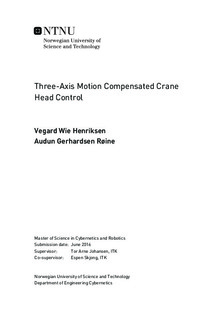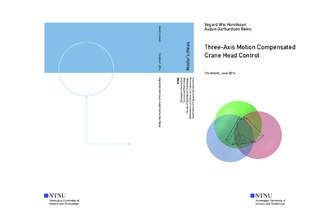| dc.description.abstract | Offshore operations can be harsh and demanding and set personnel and equipment at risk. Ships will be exposed to the environmental forces of wind, waves and current, which will influence offshore crane operations considerably. This thesis addresses the use of a crane head, a Three Axis Compensator (TAC), constructed as a Delta parallel robot, to compensate for the motions of the ship in three axes. This type of robot has a rigid and accurate structure, and because of its highly nonlinear nature, advanced control algorithms must be derived. This thesis includes both forward and inverse kinematics for the robot, as well as velocity kinematics and workspace analysis. The kinematics of a full crane system, with the TAC as its head, has also been modelled. To evaluate the control algorithms and to prove the concept of using a Delta parallel robot for motion compensation, two products were made, a simulator and a prototype of the TAC.
A simulator which includes a model of a supply ship, a full scale crane with the TAC as its head has been created. The disturbances perturbed on the system from the elements are translated and rotated to the crane head frame of reference for use in the compensation procedure. PID-regulators are used to control the crane head, and simulations are conducted to verify that the crane head is able to compensate for the motions created by waves, tested at different sea states.
In addition a small-scale prototype of the TAC has been built. This robot uses two-phase stepper motors to control the position of the Tool Center Point (TCP) which is where the cargo will be suspended. The prototype's body is of 3D-printed plastic parts (ABS), magnets, steel balls and carbon tubes, and an Arduino microcontroller board is used to control the steppers.
The sensor used to track the movements of the TAC is an Inertial Measurement Unit (IMU), which is a unit used to measure linear acceleration and rotational velocity. These signals were thoroughly filtered to avoid measurement noise on the measurements required in the control algorithms. Because of the structure's highly non-linear nature, some of the calculations in the control algorithm are strenuous affairs and are conducted in MATLAB on a computer connected to the Arduino, due to high computational costs.
The subject matter described in this thesis, merging the Delta robot with an IMU into the TAC is a novel application, and as such has resulted in a conference paper at the 10th IFAC Conference on Control Application Marine Systems (CAMS) to be held in Trondheim, Norway September 13-16, 2016. | |

